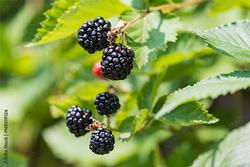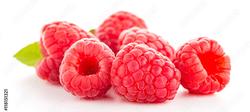Summer 2023
Small Spaces: Growing Berries in Containers
By David George

Courtesy by Shutterstock
Berries, such as the plump, juicy ‘olallie’ blackberries, sweet red raspberries, or delicious blueberries, are among the most well-liked and nutritious container-grown foods. The majority of berry cultivars ripen between late April and early July, although some also yield a second, lesser crop on young canes in the fall. Because of their high concentration of antioxidants, necessary vitamins, fiber, and trace minerals, berries have been dubbed a "superfood". Blueberries and red raspberries are both compact and well-suited for containers. While certain blackberry varieties, like olallies, sprawl and do best when planted on trellises or espaliers above their planters, others, like the erect and compact blackberry varieties, share these traits. If you place them in the proper sunlight and soil, then sometimes water and prune them, they are simple to keep.
Red raspberries and blueberries tend to have shallow root systems, so you don’t need a tall container. Blackberries have deeper roots, so a taller planter pot is a good choice. Allow for drainage and fill your pot with a high-quality container mix. Adding organic matter enriches the soil and promotes root growth and better overall plant health. It is important to consider your area’s climate for watering needs, as well as the amount of sun your container receives. Berries like full sun and regular water. Check the soil’s moisture level in its first several inches. Add water if it feels dry but don’t over saturate (standing surface water). A layer of organic mulch on top helps stabilize the moisture content and the temperature of the planter’s soil.
Blackberries

Blackberries. Courtesy of AdobeStock.
These perennial vines grow 8-12 feet per year in full sun. Most commercial blackberries are either Marion berries or Olallie berries and are ideally suited to growing conditions in coastal valleys from Oregon to San Diego. Most varieties have thorny canes, but you can also find thornless varieties. Allow new (primo-) canes to grow long and twine through your trellis during their first growing season. The next spring, they will produce side shoots (floricanes) which flower and produce mature fruit in June and July. Cut back the spent bearing canes in August to promote faster growth of next year’s primocanes.
Red Raspberries

Raspberries. Courtesy of AdobeStock.
Red raspberries are native to temperate regions around the world, including North America. Canes are erect and grow to 4 feet in part sun. Blooms appear the first fall at the tips of new canes, with rapid maturing of fruit about 2 weeks after bloom. But don’t cut them back over winter because they will produce fruit again on side shoots (floricanes) next May or June. After the spring harvest, you should cut back the old bearing canes to their base. Wear gloves to protect your hands from their prickly hairs.
Blueberries

Blueberries. Courtesy of AdobeStock.
Blueberries are native to North America but not native to California. They love acidic (low pH) nitrogen-rich soil. Dwarf or semi-dwarf varieties grow well in containers if you manage the acidity of the soil. Add peat moss, forest products, or a high-nitrogen fertilizer to your container soil, then supply regular water for a few minutes every other day if drip irrigated. Healthy blueberry plants will produce tall, straight canes with spring blooms and mid-summer fruit. Cut back the fruiting canes after production. Blueberry cultivars require at least two varieties of the same strain to cross-pollinate.
Once your berry plants start bearing fruit, they'll keep doing so for years, delivering delectable, delicious treats for your table.
Visit the UC ANR website for more details on Growing Berries - The California Garden Web.




